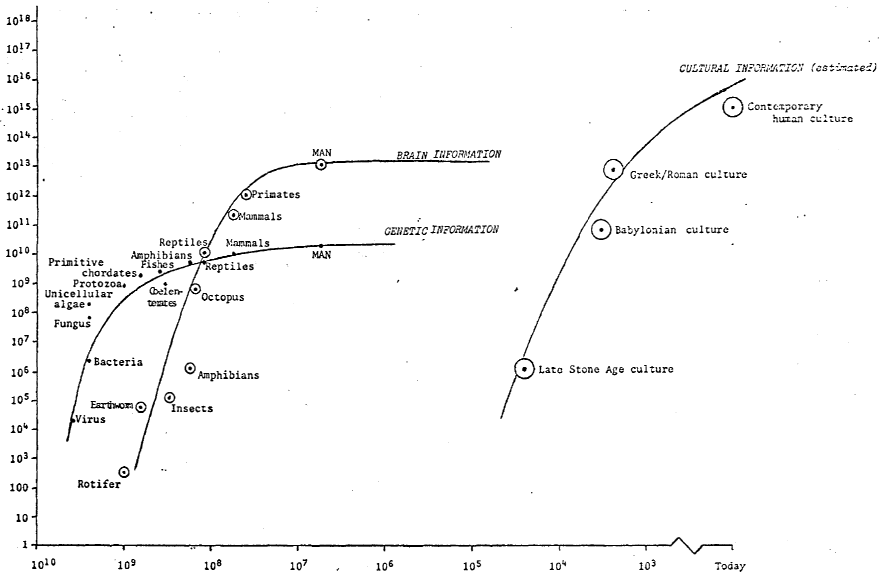| Information (in bits) |
 |
| |
Xenology: An Introduction to the Scientific Study of Extraterrestrial Life, Intelligence, and Civilization
First Edition
© 1975-1979, 2008 Robert A. Freitas Jr. All Rights Reserved.
Robert A. Freitas Jr., Xenology: An Introduction to the Scientific Study of Extraterrestrial Life, Intelligence, and Civilization, First Edition, Xenology Research Institute, Sacramento, CA, 1979; http://www.xenology.info/Xeno.htm
14.2 Juvenile Extraterrestrial Intelligences
Any organism that must sense its environment and react to it, or seek mates and reproduce, or hunt for prey and avoid being preyed upon; or which has some form of locomotion or mobility probably will discover that added intelligence is of enormous benefit and selective value. In the game of life, smarter animals generally do better than dumber animals. Certainly one of the most interesting questions from the standpoint of xenology is: Will extraterrestrials have "advanced" intellect?
To the extent that intelligence is data processing, the more information a creature and process and store the smarter it is and the more competitive it will be in the struggle for survival on its home world during its natural evolutionary phase. The fundamental unit of information is the "bit," or binary digit, briefly discussed in the previous chapter in connection with sensory apparatuses. A bit, in the parlance of information theorists, is the amount of information needed to correctly choose between two equally likely answers to a simple yes/no query.
Let’s take an example. The English alphabet has 26 letters. If you play "Twenty Questions" with a friend who has some single letter in mind, it’s possible to guess which one it is by asking as few as five independent yes/no questions. (Try it.) Thus, theorists argue that a printed letter represents exactly five bits of information. The average five-letter word therefore has 5 x 5 = 25 bits, and so forth.
Figure 14.3 is a map of the various forms of biological information storage found on planet Earth. There are three curves, defining a clear progression from lower to higher capacity.
| Information (in bits) |
 |
| |
The lowest curve represents the amount of data stored in the genes of terrestrial organisms. Judging from its antiquity, genetic information storage appears to be the slowest, most time-consuming means available to living creatures. On timescales of millions of years, changes in the information stored per genome are imperceptible. Evolution evidently is a very slow intelligence.
The middle curve shows the storage of data in the brains of animals. This is a much faster process -- large changes are readily apparent over time-scales of millions of years. The number of bits stored per entity, as well as the complexity of behavior, is greater with brains than with genes. Still, on timescales of millennia there is little change in the maximum quantity of information capable of being stored by a single biological brain.
The highest curve at the far right displays the amount of data stored in human cultures as a function of time. Sociocultural bit-storage is at once the most volatile and the most efficient technique, representing another quantum leap in overall capability. Change is rapid on timescales of millennia, and long ago surpassed the levels of the other two curves. In a sense, social evolution may be viewed as an extremely fast intelligence.
From these three curves, we may define three distinct orders of possible "advanced" alien sentience. Accepting tentatively the speculation that level of intelligence may depend in part upon the ability of an organism to assimilate information, we can imagine three distinct ways in which the quality of intellect may be worked out in biology. We shall call these "genetic sentience," "brain sentience," and "communal sentience," three steps along the path of ever-increasing intelligence.
Last updated on 6 December 2008